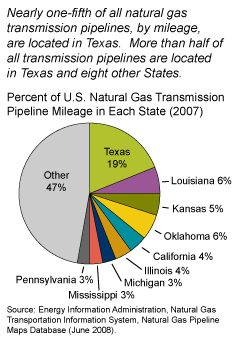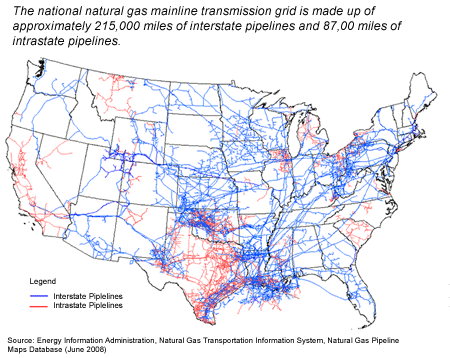
What Makes Up This Transportation Network?
An intricate transportation system, made up of about 1.5 million miles of pipelines, links production areas and natural gas markets. Transporting natural gas from the production field to the consumer involves a series of steps, generally carried out in order:
- Gathering systems, primarily made up of small-diameter, low-pressure pipelines, move raw natural gas from the wellhead to a natural gas processing plant or to an interconnection with a larger mainline pipeline.
- Processing plants separate natural gas liquids and impurities from the natural gas stream before the natural gas is delivered into a mainline transmission system.
- About 302,000 miles of wide-diameter, high-pressure interstate and intrastate transmission pipelines transport natural gas from the producing area to market areas. Compressor stations (or pumping stations), located strategically along the length of the pipeline network, keep the natural gas flowing forward along the pipeline system.
- Underground storage facilities, fashioned from depleted oil, natural gas, or aquifer reservoirs or salt caverns, are used to store natural gas as a seasonal backup supply. When needed, this reserve is withdrawn to meet additional customer demand during peak usage periods. Aboveground liquefied natural gas storage facilities are also used for this purpose.
- Local distribution companies deliver natural gas to end users through hundreds of thousands of miles of small-diameter service lines. Local distribution companies reduce the pressure of the natural gas received from the high-pressure mainline transmission system to a level that is acceptable for use in residences and commercial establishments.
How Did this Transmission and Distribution Network Become So Large?
About 142,000 of the current 302,000 miles of the mainline natural gas transmission network was installed in the 1950s and 1960s as consumer demand for low-priced natural gas more than doubled following World War II. In fact, about half of the natural gas pipeline mileage currently installed in Texas and Louisiana, two of the largest natural gas production areas in the country, was constructed between 1950 and 1969. By the close of 1969, marketed natural gas production exceeded 20 trillion cubic feet for the first time.
A large portion of the 1.2 million miles of local distribution pipelines, which receive natural gas from the mainline transmission grid and deliver it to consumers, was also installed during the same period. However, the period of greatest local distribution pipeline growth has been more recent. In the 1990s, more than 225,000 miles of new local distribution lines were installed to provide service to the many new commercial facilities and housing developments that wanted access to lower-priced natural gas supplies during that period of economic growth.
The demand for natural gas has grown in recent years in part because it is considered a relatively environmentally-friendly energy source. Its use as an electric power generation fuel also has grown steadily with a decline in the capital costs of producing electric power from natural gas as technology in the area has improved.
Natural gas prices, along with oil prices, have increased substantially over the past 5 years. Higher prices gave natural gas producers the incentive to expand development of new natural gas fields. Consequently, new pipelines have been and are being built to link these new production sources to the existing mainline transmission network. Construction of new transmission and local distribution mainline pipeline mileage during the current decade, 2000-2009, is projected to surpass that of any other decade since the 1950s.1


